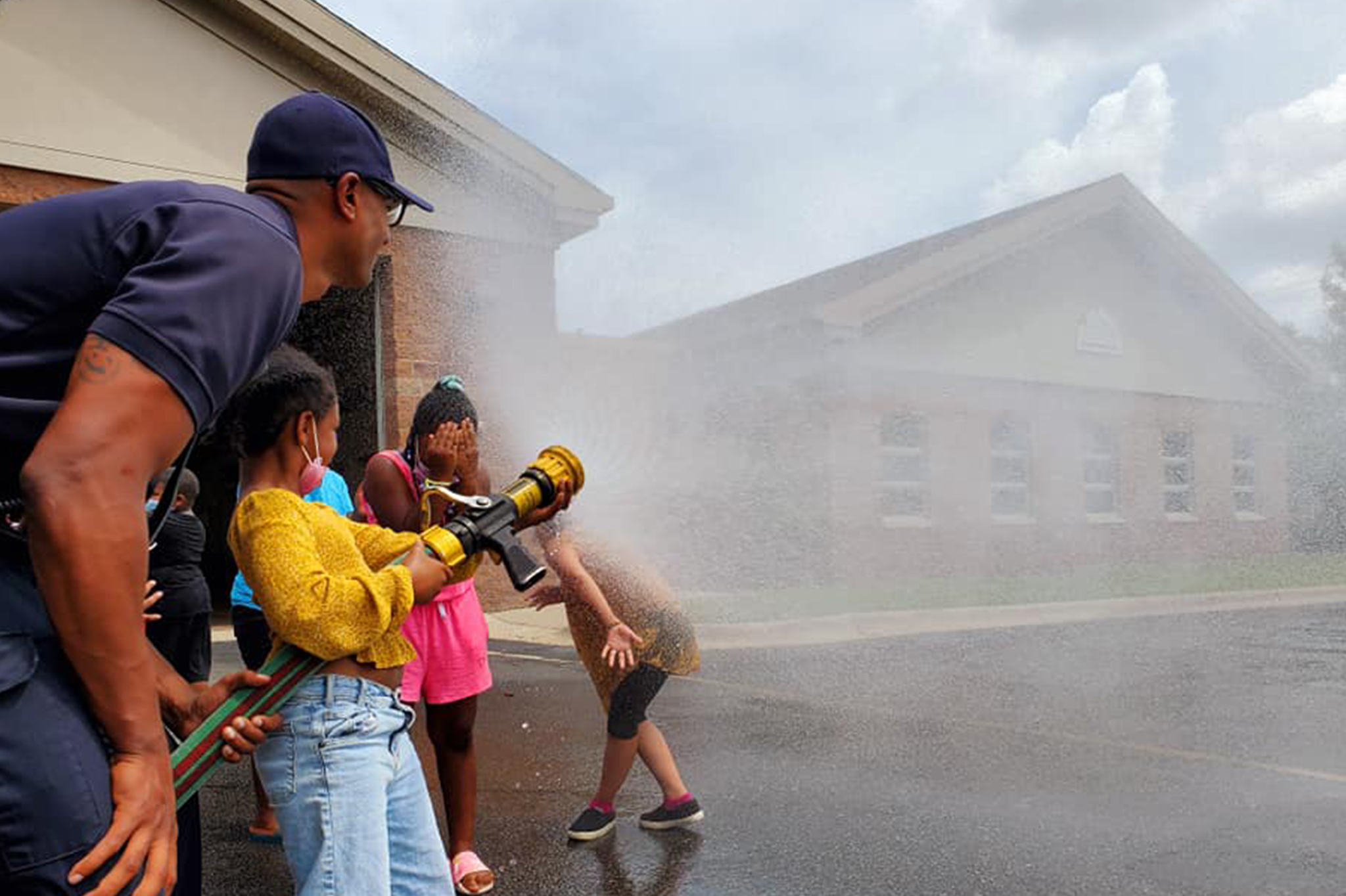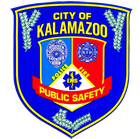Contact Us
To provide feedback on the Community Policing Dispatch, e-mail the editorial board at CPDispatch@usdoj.gov.
To obtain details on COPS Office programs, publications, and resources, contact the COPS Office Response Center at 800-421-6770 or AskCopsRC@usdoj.gov

U.S. Department of Justice
Office of Community Oriented Policing Services
Washington, DC 20530
 Playing with cops was cool—literally and figuratively—for the kids at the Kalamazoo (Michigan) Department of Public Safety’s (KDPS) camp one hot July day in 2022.
Playing with cops was cool—literally and figuratively—for the kids at the Kalamazoo (Michigan) Department of Public Safety’s (KDPS) camp one hot July day in 2022.
Said KDPS Officer Devin Palmer, “I let them try to hold the hose with me—spraying it into the air and so they could run around and cool off before their lunch with me and the other firefighters. They had a great time and so did I.
“We hold events like this every summer at our different stations,” Palmer added. “What’s especially cool is that the kids get to engage with police, firefighters, and EMS people. They get some hands-on experience with our equipment too, which they really enjoy.”
One of the largest combined public safety departments in the country, the KDPS employs 257 people in one unified organization—police, fire, and EMS—that serves approximately 75,000 people in this Michigan city midway between Detroit and Chicago. Like all KPDS officers, Officer Palmer is a certified police officer, firefighter, and medical first responder, but his main focus is currently responding to calls with fire apparatus and medical vehicles.
“I am qualified for all three areas,” said Officer Palmer, “but am currently functioning on the fire side full time. Firefighters are armed, too, though most people don’t realize that we’re both law enforcement and fire.”
Added KDPS Chief David Boysen, “Our officers have been fully cross-trained since 1982. Recruits go through training for all three units in a police academy accredited by the Michigan Commission on Law Enforcement (MCOLES).
“Following this, they attend our in-house firefighter training to receive their Firefighter 1 and 2 certification. After that, they go on to our in-house Medical First Responder (MFR) training. For both, they are required to pass the state test.
“Once these trainings are completed, recruits go through our Advanced Police Academy and then our field training program. Upon successful completion of all training, they are released for solo patrol. This whole process usually takes about one year from the date of their initial hiring.”
Community Relations, Officer Morale, and the City Benefit
 Cross training is a huge benefit to the community, Chief Boysen said. “In many fire departments, the personnel wait in the station for a call. Ours can be out on streets patrolling while they’re waiting. It’s a force multiplier, which enables quicker responses on the street and cost savings for the city.
Cross training is a huge benefit to the community, Chief Boysen said. “In many fire departments, the personnel wait in the station for a call. Ours can be out on streets patrolling while they’re waiting. It’s a force multiplier, which enables quicker responses on the street and cost savings for the city.
“Since our officers are trained in three disciplines, they can respond to a variety of incidents, and by bringing additional skills in firefighting, law enforcement, or emergency medicine to the scene, be more effective in many instances.
“Combining three skill sets in one department adds to department morale because it changes things up in their jobs and there are more opportunities to pursue different careers, too. Some officers want to specialize on the fire side and are assigned to that station. Or, if they prefer the law enforcement end, there are lots of opportunities in that area.
“Another specialty is EMS, and our firefighters and front-line patrol officers can provide this assistance as well. It helps us build relationships, too, because we respond to more and different kinds of incidents. Our Public Safety Officers assigned to patrol get the same medical training as the officers that work on the fire side.
“Also, I think that the individuals who are attracted to this kind of service have more compassion because they don’t want to just make arrests. They’re going into homes where people have had fires and medical emergencies. Helping in situations like these requires compassion.
“As for community policing, on the law enforcement end, it is about balancing outreach and enforcement—neither of which works alone. Combining them gives you the most impact and effect on reducing crime because it creates meaningful relationships.”
My90 Community Survey Measures Performance
To enhance those relationships, the KPDS supports a wide variety of programs, from youth camps to National Nights Out to regular meetings with community groups.
Their most recent community policing effort was the April 2023 launch of the My90 survey tool. Developed by Axon, a provider of public safety technologies, My90 collects anonymous data on officers’ and dispatchers’ interactions with the public.
“We believed we were doing a good job of supporting public safety but wanted a mechanism to measure how our citizens felt about us and identify ways we could do better,” Chief Boysen said.
The department used two survey tools. One was for individuals reporting a problem by cell phone. After the call, they got a text inviting them to fill out a questionnaire about how satisfied they were with the response. The second survey was given to drivers after a traffic stop. Officers offered them cards with questions such as, “Did the officer explain how to take care of the citation and why you got it?” The cards had a QR code community members could access to leave replies.
“We just got results for 30 days of implementation and scored very high for positive interactions in both surveys,” said Chief Boysen. “Usually people aren’t happy to be pulled over, but 92 percent said they were treated fairly. It’s completely anonymous, and in both surveys there is an area where they can make comments. These results are great for staff morale, and they can help de-escalate situations too.”
A third My90 survey was sent out to all employees’ cell phones in May, asking questions centered around work satisfaction, mental and physical health, resources needed to successfully complete their jobs, and whether the employee is considering leaving the organization for another career opportunity.
Of the department’s 263 sworn and nonsworn employees, 200 responded. The answers they gave provided significant insights, which the department will use to strengthen the organization and address any challenges employees reported facing. Based on their positive reaction to the survey and the usefulness of the information gathered from it, the KDPS plans to send out quarterly employee surveys in the future.
A Citizens’ Academy for Skeptics
Another new and notable program is the spring session of the Kalamazoo Regional Citizens Academy. A second iteration of the department’s fall program, it was held in the hopes of attracting people who don’t like police.
Chief Boysen realized that the fall Citizens Academy attracted participants who already held a positive view of the KDPS—and that event was therefore like preaching to the choir. So, he decided to hold a Citizens Academy for individuals who don’t trust law enforcement. “They see bad things about police in other parts of the country and assume that we’re all the same,” he said. “But the skeptics who came to our spring session were big supporters of us at the end of the program.”
An example he cited was of a meeting at Western Michigan University. “A young man who had attended the program stood up and said to the group, ‘Before I attended the Citizens Academy I had a negative opinion of policing, but this opened my eyes. Police have a tough job and they do amazing work.’”
The training, which is hosted by KDPS in collaboration with the Kalamazoo County Sheriff’s Office, Kalamazoo Township Police Department, Portage (Michigan) Department of Public Safety, Western Michigan University Police Department, Michigan State Police, and U.S. Drug Enforcement Administration, includes a lot of role-playing through the KDPS’s virtual reality system. Said Chief Boysen, “Participation in shoot/don’t shoot, traffic stops and other situations gives attendees a much greater understanding of the stress officers work under and appreciation of our job.”
Speaking of KDPS programs that, like the Citizens Academy, are created to increase mutual understanding and trust with residents of the Kalamazoo area, Officer Palmer commented, “The community outreach and relationships we’ve built make a real difference. They’re like a goodwill bank we can draw on at times we have to do things that the public might not understand. The community knows we’re really good people.”
Faye C. Elkins
Sr. Technical Writer
COPS Office
Subscribe to Email Updates
To sign up for monthly updates or to access your subscriber preferences, please enter your email address in the Subscribe box.






